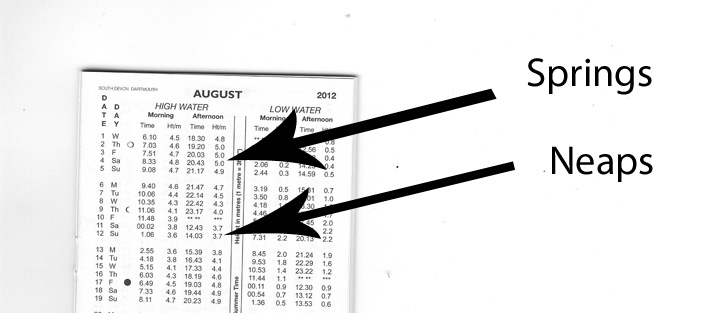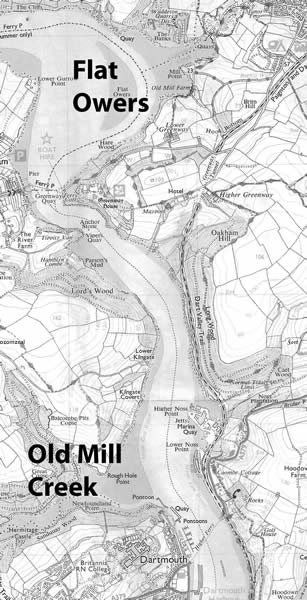A Brief Guide to Tides
Members wanting to use club craft should learn how to read tide tables. The key is to be able to predict when high tide (or low tide) will be. Sit on tops and paddleboards are slow and not good at going against the tide, even faster sea kayaks struggle a bit.
Today's tides can be found by following the link to www.tidetimes.org.uk
The simplest plan is to identify the time of high tide and head upriver about an hour before it. Or alternatively identify the time of low tide and head out to a beach an hour before it. This is a good basic rule for planning paddles for those new to tides.
It is also helpful to work out if it is a spring tide or not.
A ‘Spring Tide’ means:
- A big change in level from High Water to Low Water
- High tide in the range 4.8m - 5.3m indicates a spring tide
- Lots of water has to get in and out of the river
- Currents will be quite strong except at high and low water
- At low tide there will be beaches and areas of mud
- Spring Tides occur when the moon is full or at no moon
‘Neap Tides’ are the opposite
- The water height at high tide is much less
- The water does not go so far down at low tide
- High water 3.6m - 4.2m indicates a neap tide
- Not much water has to go in and out of the river
- Currents will not be very strong
- Neap tides occur when there is a half moon
Tide tables cost about £3 and allow you to look ahead at the tide times for future days. They look like this:

You can see several days in a row the tide is 5.0m high or so, those are days with spring tides. Soon after there are several days with tides of about 3.7m or so, those are neap tides.
Example
>Friday 3rd August
The numbers tell you that in the evening at 20.03 (8.03pm) the height of the tide is 5.0 metres. A tide with a height of about 5.0m is a spring tide. So expect strong currents. This might be a good evening to go upriver setting out at about 7pm and returning about 9pm, so long as daylight will last that long. The tide will be with you both ways and you will have calm slack water around 8pm. Another way to plan a paddle on this day is during the middle of the day when low tide is at 13.42 (1.42pm). You could set out at about 12.30 and paddle out to a beach just past Dartmouth Castle, returning about 2.30pm. Again the tide will be with you both ways.
Choosing when to start your trip and which way to go matters a lot when there is a spring tide – get it wrong and you may have strong currents to paddle against.
Example
Sunday 12th August
date day am pm
The heights of the high tides this day are 3.6 - 3.7m. These are neap tides, the currents this day will be fairly weak. High tide is at 2.03pm. This might be a good day to paddle up towards Dittisham for lunch. The tide would be with you both ways. But you don't have to plan to have the tide with you as it is weak. You could paddle against the tide without much trouble. So you could get on the water whenever you want and paddle whichever way you want, it won't matter much. Neaps are easier for beginners, less can go wrong.
Mud:
Something to bear in minde if you take your sit on top into shallow water when the tide is falling: There are large areas of mud that appear at low tide and you could get stuck. Yes, you can get off and wade through mud, dragging your boat to escape (take your shoes off) but you will not look back on it all as one of your better days out. The areas where you are most likely to get stuck on the mud on a falling tide are:
Old Mill Creek - just upriver from the Naval College, an area much visited by our club's sit on top paddlers.
Flat Owers - an area in the middle of the very widest part of the estuary between Dittisham and Galmpton. A large triangular mud island appears at low tide which is notorious for ensnaring unwary owners of yachts and motorboats and keeping them firmly in its clutches until the tide comes back in hours later.

More Tide Tips:
If you have to paddle against the tide it is always better to stay really tight close to the side of the river. The strength of the current is fastest in the centre of the river and will be slower if you are close to the edge - a boats length or two from the side is often best.
If it is spring tides this weekend, it will be neap tides next weekend. It changes that fast. Why? In one month, the moon passes through these four steps, roughly one a week.
full moon spring tides
half moon neap tides
no moon spring tides
half moon neap tides
The small circles in the tide tables indicate moon stages: - Aug 2nd is full moon, Aug 9th is a half moon, Aug 17th is no moon. Whenever you see the moon you learn a bit about the tide. See a half moon and it's neaps - see a full moon and it's springs.
If you get tables unadjusted for summer time you may have to add an hour to the times. Yachtsmen prefer this type so they are sold but kayakers should avoid them as they often lead to errors of an hour when you forget to make the adjustment. The Spar shop by the market sells the best tide tables which are pre adjusted for British Summer Time. These are the ones you should buy.
In Dartmouth, when there are spring tides it is normal for the time of high tide to be roughly 8am and 8pm, plus or minus an hour or two. You won't get a spring high tide at lunchtime. A neap tide is always high about lunchtime. This is a local rule, it would not apply in other harbours.
The tide is strongest where the river is narrowest, eg near Dittisham and between the castles at Dartmouth.
The time of high tide gets later each day (by a bit under an hour). Why? If you are directly under the moon now you won't be in 24 hours time because the moon will have moved on a bit (by 1/28th of its orbit). The time lag to be under it again is the time by which the tide gets later, this is roughly 50 minutes each day.
You don't need to master every facet of tides to be safe. For beginners, just work out when the time of high water is and set off upriver an hour before it and you won't go wrong. Or know when the time of low water is and set off out to a beach an hour before that. The tide will then help you both ways on your paddle.
